December 6, 2023

Embarking on the Annapurna Circuit Trek guarantees not only awe-inspiring landscapes but also a culinary and hospitality journey. As you traverse the trail, you’ll encounter a range of dining options, predominantly offered by teahouses and local eateries. These establishments provide a mix of traditional Nepali fare like Dhal-Bhat and mo:mo, alongside international dishes to cater to diverse tastes. The meals served not only satisfy hunger but also replenish the energy required for the trek.
Hydration is key during any trek, and the Annapurna Circuit ensures a steady supply of beverages. Teahouses and lodges present an array of options, from hot teas and coffee to locally brewed drinks. It’s advisable to carry a reusable water bottle and consider water purification methods to ensure a safe and constant water source throughout the journey.
Accommodation choices along the route vary, accommodating different preferences and budgets. Teahouses, known for their communal atmosphere, offer basic amenities such as beds with blankets and shared facilities. For those seeking more comfort, some lodges provide private rooms with attached bathrooms, allowing for a more personalized and relaxed experience. Ultimately, the combination of diverse culinary experiences, refreshing beverages, and comfortable accommodations enriches the Annapurna Circuit Trek, making it not just a physical adventure but a holistic journey through the heart of the Himalayas.
1.1 Breakfast
1.2 Lunch and Dinner
1.2.1 Diverse Menu at Tea Shops
1.2.2 Local Flavors to Explore
2.1 Drinking Water
2.2 Hot Drinks
2.3 Refreshing Soft Drinks
2.4 Sipping Alcoholic Beverages
3.1 Welcoming Tea Houses
3.2 Comfortable Lodges
4.1 Cozy Rooms
4.2 Hygienic Restrooms
4.3 Staying Connected: Internet Access
5.1 : Kathmandu
5.2: Besisahar
5.3: Bahundanda
5.4: Chamje
5.5: Bagarchap
5.6: Chame
5.7: Pisang
5.8: Manang
5.9: Acclimatization day in Manang
5.10: Yak Kharka
5.11: Thorong Phedi
5.12: Muktinath (via Thorong La Pass)
5.13: Marpha
5.14: Kalopani
5.15: Tatopani
5.16: Ghorepani
5.17: Pokhara

Chapati with vegetable curry
The breakfast options on the Annapurna Circuit Trek can vary depending on the teahouse or lodge you are staying at, as well as the altitude. However, I can provide you with a general idea of the typical breakfast items you might find:
Oatmeal/Porridge:
Instant oats are lightweight and easy to prepare.
Add dried fruits, nuts, and a bit of honey for flavor and extra energy.
Granola with Milk or Yogurt:
Granola is a good source of carbohydrates and can be mixed with powdered milk or yogurt.
Eggs:
Boiled, scrambled, or fried eggs are a good source of protein.
Carry boiled eggs if you want a quick and easy option.
Pancakes or Crepes:
Pre-made pancake or crepe mix can be carried and cooked with minimal effort.
Top with honey, nut butter, or jam.
Bread and Nut Butter:
Pack some whole-grain bread and nut butter (peanut butter, almond butter) for a quick and satisfying breakfast.
Fruit Salad:
Fresh fruits are a good source of vitamins and minerals.
Pre-cut and mix fruits like bananas, apples, and oranges for a refreshing start.
Muesli:
Muesli is a mix of rolled oats, dried fruits, nuts, and seeds.
It can be eaten with milk or yogurt and requires no cooking.
Local Breakfast Options:
Try local dishes like Tibetan bread, chapati, or dal bhat, a traditional Nepali meal consisting of lentil soup, rice, and vegetables.
Tea and Coffee:
Hot beverages can be a great way to start the day. Carry instant coffee or tea bags.
Energy Bars and Trail Mix:
These are convenient and provide a quick energy boost.
Look for bars with a good balance of carbs, protein, and fats.
Instant Noodles or Pasta:
Lightweight and easy to cook, these can be a more substantial breakfast option.
Remember to consider the weight and packing constraints while planning your meals. Additionally, stay hydrated by drinking plenty of water throughout the trek. Adjust portion sizes based on your energy expenditure and appetite.
Lunch and dinner during the Annapurna Circuit trek are crucial for replenishing energy and satisfying hunger after a day of hiking. These meals provide an opportunity to refuel with a mix of carbohydrates, proteins, and fats. Local and lightweight options are preferred, considering the challenging trekking conditions. Here’s a selection of foods suitable for lunch and dinner:
Dal Bhat:
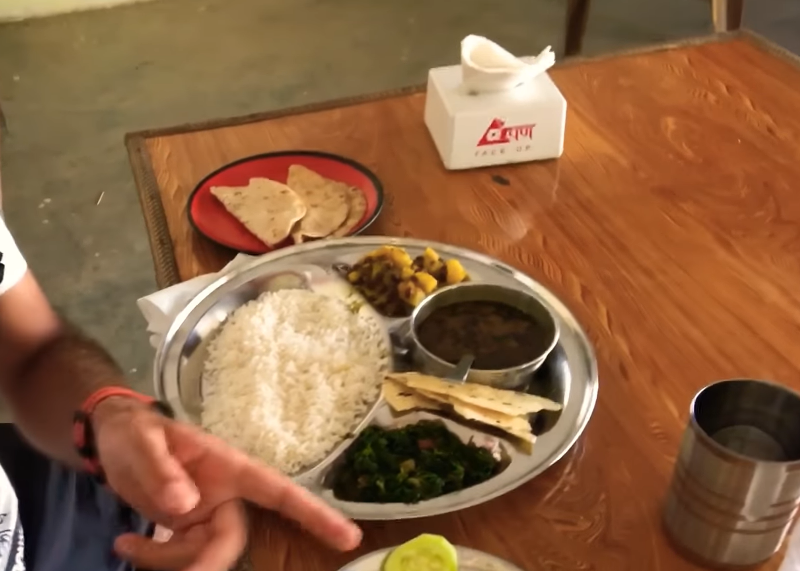
Nepali local Food- Dhal Bhat
A staple Nepali dish, Dal Bhat consists of lentil soup (dal), rice, vegetables, and sometimes meat. It’s a well-balanced meal rich in nutrients.
Vegetable Curry:
Featuring locally sourced vegetables, this curry is flavorful and provides essential vitamins and minerals.
Rice and Lentils:
A simpler version of Dal Bhat, it offers a quick and nourishing option.
Noodles:
Instant noodles or traditional Tibetan noodles can be prepared with veggies and protein for a satisfying meal.
Pasta:
Lightweight and easy to carry, pasta with sauce is a convenient dinner option.
Fried Rice:
Prepared with rice, vegetables, and protein, fried rice is a tasty and filling choice.
Soup:
Warm soup, whether vegetable or noodle, is both comforting and hydrating.
Momos:
Nepali dumplings filled with meat or vegetables, momos offer a flavorful and portable meal.
Bread and Spread:
Carry flatbreads or Tibetan bread with spreads like cheese, peanut butter, or jam for a quick lunch.
Energy Bars:
Convenient for a mid-day boost, energy bars with a mix of nuts, fruits, and grains are easy to pack.
Local Teahouse Specials:
Explore local teahouses for regional specialties and cultural culinary experiences.
Balancing nutrition, convenience, and local flavors, these lunch and dinner options cater to the needs of trekkers, providing the sustenance required to conquer the stunning yet challenging Annapurna Circuit.

One of the delightful aspects of trekking the Annapurna Circuit is the diverse menu offered at the tea shops along the route. These quaint establishments not only provide much-needed rest for weary trekkers but also present a varied selection of dishes to cater to different tastes and dietary preferences.
Tea shops offer a range of local and international options, including the traditional Nepali staple, Dal Bhat, a hearty combination of lentil soup, rice, and vegetables. For those seeking a quick and energizing snack, momos (dumplings) filled with meat or vegetables are a popular choice.
Moreover, tea shops often serve up delicious noodle soups, providing warmth and comfort in the mountainous terrain. Local teas, such as masala chai, add a touch of warmth and flavor to the dining experience.
As trekkers traverse diverse landscapes, the menu diversifies accordingly. From simple rice and lentil dishes to more elaborate pasta and noodle variations, the tea shops cater to the nutritional needs of hikers while embracing the local culinary flair.
In essence, the diverse menu at tea shops not only fuels the body for the trek but also enriches the overall trekking experience by offering a taste of the region’s culinary diversity. It’s an opportunity for trekkers to refuel, rest, and savor the unique flavors that accompany the breathtaking views of the Annapurna Circuit.
Exploring the Annapurna Circuit isn’t just a visual feast—it’s a culinary adventure too. Embrace local flavors at teahouses, savoring regional delicacies like Dhido, a traditional buckwheat or millet-based dish, paired with Gundruk, fermented leafy greens. Don’t miss the chance to indulge in Yak cheese, a Himalayan specialty, or sample Thukpa, a hearty noodle soup. Sweet endings await with Sel Roti, a crispy rice doughnut, and the aromatic sweetness of Gurung bread. These local delights not only nourish the body but offer a taste of the rich cultural tapestry that makes the Annapurna Circuit a sensory delight for trekkers.
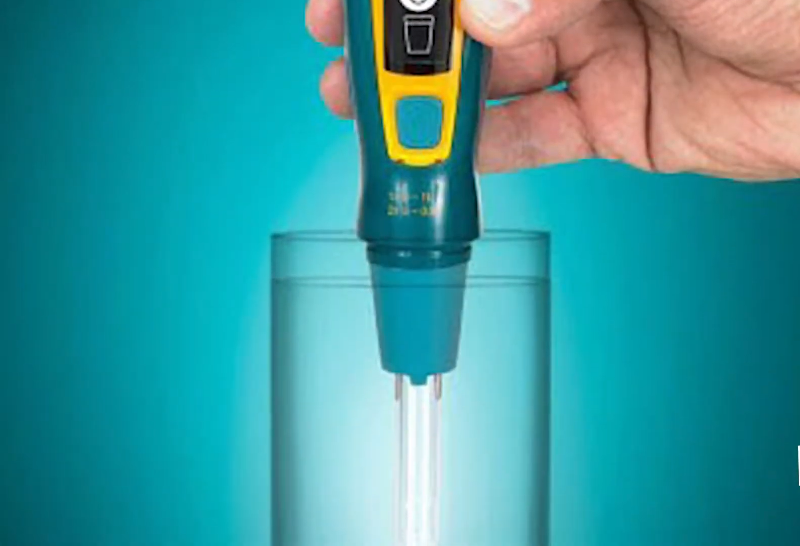
Water filter
Quenching your thirst is crucial, especially during a challenging trek like the Annapurna Circuit. Staying hydrated is essential for your well-being and performance at high altitudes. Here are some tips for drinking water during the Annapurna Circuit trek:
Water Sources:
Carry a reusable water bottle or hydration system. Make sure it has a good capacity, as there may be long stretches between water sources.
You’ll find several natural water sources along the trail, such as streams and rivers. However, it’s crucial to treat or purify this water before drinking to avoid waterborne illnesses. Water purification tablets or a portable water filter can be handy.
Lodges and Teahouses:
The Annapurna Circuit has numerous lodges and teahouses along the route. These places often provide safe, filtered water for trekkers. Ask for boiled or filtered water, and carry purification tablets as a backup.
Purification Tablets or Filters:
Bring water purification tablets or a reliable water filter. This ensures that you can treat water from various sources and have a backup in case your primary water source runs out.
Acclimatization Days:
Acclimatization is crucial at higher altitudes. During rest/acclimatization days, focus on hydrating well. This helps your body adjust to the altitude and reduces the risk of altitude sickness.
Electrolyte Replenishment:
Consider carrying electrolyte tablets or a hydration mix. Sweating and increased activity at higher altitudes can lead to a loss of essential minerals. Replenishing electrolytes is important for maintaining a proper fluid balance.
Monitoring Hydration:
Pay attention to the color of your urine. Dark yellow urine may indicate dehydration. Aim for light yellow to clear urine as a sign of adequate hydration.
Avoid Overhydration:
While staying hydrated is crucial, overhydration can lead to a condition called hyponatremia. This occurs when the balance of electrolytes in your body is disrupted. Drink water steadily throughout the day but avoid excessive intake in a short period.
Hot Water Bottles:
In teahouses, you can often request hot water bottles in the evening. These can be placed inside your sleeping bag to provide warmth during cold nights and may serve as a backup source of warm water for drinking.
Remember that water needs vary from person to person and depend on factors such as activity level, weather conditions, and altitude. Be proactive in ensuring you have access to safe and clean water throughout your Annapurna Circuit trek.
During the Annapurna Circuit trek, hot drinks are a comforting respite from the challenging terrain and varying temperatures. At teahouses nestled along the route, cozy up with steaming cups of local delights like masala chai or hot lemon tea. These aromatic beverages not only provide warmth against the mountain chill but also serve as a social catalyst, fostering camaraderie among fellow trekkers. Sip leisurely while soaking in breathtaking views, allowing the revitalizing warmth to penetrate your body. The ritual of enjoying hot drinks becomes a cherished part of the trek, invigorating both body and spirit amidst the awe-inspiring landscapes of the Himalayas.
During the Annapurna Circuit trek, finding refreshing soft drinks can be a challenge as the availability of such beverages is limited, especially in the more remote areas. Teahouses and lodges along the trail may offer basic selections like cola, soda, or bottled water, but the variety can be sparse. It’s advisable to manage expectations and embrace the trek as an opportunity to enjoy local and natural refreshments. While some places may have a modest selection, trekkers often prioritize staying hydrated with water and electrolyte-rich beverages due to the demanding physical exertion and high-altitude conditions.

Khukri Rum – Best rum In Nepal
The Annapurna Circuit trek in Nepal offers trekkers the opportunity to experience a variety of local alcoholic beverages. Here are some of the drinks you might encounter during your trek:
Rakshi: This is a traditional distilled spirit in Nepal, often made from millet or rice. It’s a strong, clear liquor and is quite popular in the local communities.
Chhyang: Chhyang is a traditional fermented alcoholic beverage made from rice, barley, or millet. It’s a milky, slightly sour drink with a mild alcoholic content.
Nigar: Nigar is a type of local moonshine or homemade alcohol. The production methods can vary, and it’s often made in small batches by locals.
Apple Brandy: In regions with apple orchards, you might find locally produced apple brandy. This drink is made by distilling fermented apple juice or cider, resulting in a strong, fruity spirit.
Beer: Some trekking lodges and teahouses along the Annapurna Circuit may have imported or locally brewed beers. Brands like Everest, Gorkha, and Sherpa are common in the region.
Chang: Chang is a type of traditional beer brewed in Tibetan communities. It’s made from barley and has a mild, slightly sweet taste. You might find this in areas with a significant Tibetan influence.
It’s important to note that consuming alcohol at high altitudes, such as those encountered during the Annapurna Circuit trek, can have more pronounced effects due to lower oxygen levels. It’s advisable to drink responsibly and in moderation, taking into consideration the potential impact on your health and acclimatization. Additionally, drinking plenty of water is crucial to stay hydrated, especially in the mountainous terrain. Always be aware of your own limits and prioritize your safety during the trek.
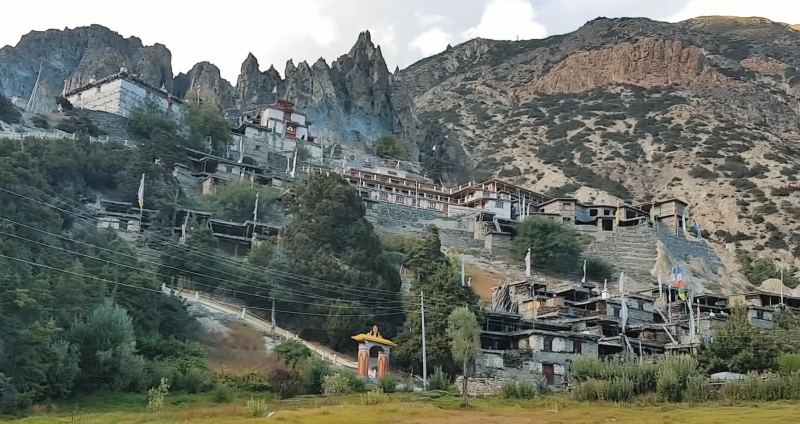
Traditional Soil made Houses in Annapurna circuit trek
Resting amidst nature’s beauty during the Annapurna Circuit Trek is a truly rejuvenating experience. The trek takes you through some of the most stunning landscapes in the Himalayas, offering a perfect blend of adventure and serenity. Here’s a glimpse of what you might experience during your rest stops along the Annapurna Circuit:
Picturesque Views: One of the highlights of the Annapurna Circuit is the breathtaking scenery. As you rest, you’ll be surrounded by majestic snow-capped peaks, lush green valleys, and charming villages. Take the time to absorb the beauty and capture the moments through photographs.
Teahouse Hospitality: Along the trekking route, you’ll find teahouses that offer a cozy and welcoming atmosphere. Resting in these teahouses allows you to interact with fellow trekkers, locals, and the hospitable tea house owners. Enjoy a warm cup of tea or a hearty meal while taking in the views.
Tranquil Villages: The circuit passes through several traditional villages, providing an opportunity to witness the local way of life. Resting in these villages allows you to observe the unique culture, architecture, and hospitality of the Gurung and Thakali communities.
Natural Hot Springs: Near the village of Tatopani, you can relax in natural hot springs, a perfect way to soothe your muscles after a day of trekking. The warmth of the water against the backdrop of the Himalayas creates a serene and unforgettable experience.
Sunrise and Sunset Views: Some of the rest stops may offer excellent vantage points for sunrise and sunset views. Poon Hill, a popular side trek along the Annapurna Circuit, is renowned for its stunning panoramic sunrise over the Annapurna and Dhaulagiri mountain ranges.
Serenity of High-altitude Lakes: As you ascend higher, you may come across serene high-altitude lakes like Tilicho Lake. Resting beside these pristine lakes surrounded by towering peaks provides a unique and tranquil experience.
Cultural Exploration: Explore ancient monasteries, stupas, and chortens that dot the landscape. These cultural stops provide not only a chance to rest but also an opportunity to delve into the rich religious and cultural heritage of the region.
Contemplation and Reflection: Amidst nature’s beauty, you’ll find moments of solitude. Use these moments for introspection, meditation, or simply to appreciate the stillness and vastness of the Himalayan landscapes.
Nestled along the enchanting Annapurna Circuit Trek, Welcoming Tea Houses offer weary trekkers a serene respite amidst the Himalayan grandeur. These charming establishments, scattered through quaint villages and lush landscapes, extend warm hospitality to adventurers seeking solace and sustenance. With rustic interiors, aromatic brews, and panoramic mountain views, these tea houses become havens for trekkers, fostering camaraderie and cultural exchange. Welcoming hosts serve traditional Nepali cuisine, providing a taste of local flavors. As the sun sets behind towering peaks, trekkers find solace in the cozy ambiance, forging memories of restful nights amid nature’s embrace on their journey through the awe-inspiring Annapurna region.
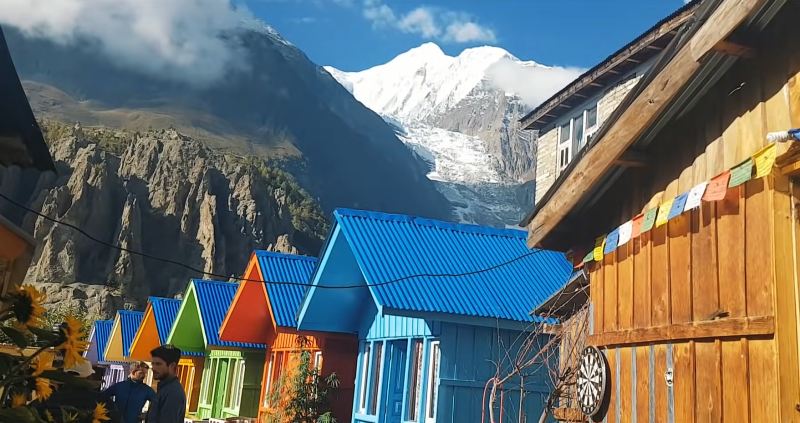
Tea House at Manag- Annapurna Circuit Trek
The Annapurna Circuit is a popular trekking route in Nepal that offers stunning views of the Annapurna and Dhaulagiri mountain ranges. Along the trail, trekkers can find a variety of comfortable lodges and tea houses to provide accommodation and meals. These establishments cater to the needs of trekkers, ensuring a cozy and convenient stay during their trek. Here’s a description of what you can typically expect from lodges and tea houses along the Annapurna Circuit:
Basic Accommodations:
Lodges and tea houses provide basic yet comfortable accommodations. Rooms usually consist of simple beds with clean bedding.
Rooms may be shared or private, depending on your preference and availability.
Common Areas:
These establishments often have common areas where trekkers can relax, socialize, and enjoy the warmth of a common fireplace.
Common areas may be adorned with traditional Nepali decor, creating a cozy and cultural atmosphere.
Dining Facilities:
Meals are typically served in a communal dining area. Most lodges offer a variety of local and international dishes.
The menus often include familiar items like pasta, rice dishes, soups, and more, providing a mix of energy-boosting foods for trekkers.
Hot Showers and Toilets:
Many lodges now offer hot shower facilities, a welcome amenity after a day of trekking in varying weather conditions.
Western-style or squat toilets are commonly available, and most places ensure cleanliness in these facilities.
Electricity and Charging:
While electricity may not be available 24/7, most lodges have designated charging areas where trekkers can recharge their electronic devices.
Scenic Locations:
Lodges and tea houses are strategically located along the trekking route, often providing breathtaking views of the surrounding mountains and landscapes.
Friendly Staff:
The staff at these establishments are usually friendly and accommodating, providing a warm and hospitable atmosphere for trekkers.
Altitude Considerations:
As you ascend on the Annapurna Circuit, accommodations may become more basic due to the challenging logistics of providing services at higher altitudes. However, they still aim to ensure comfort and safety.
Nestled along the breathtaking Annapurna Circuit, the cozy rooms provide a haven for trekkers seeking respite after a day of exploration. Adorned with simplicity, each room boasts twin-sharing beds adorned with warm, inviting blankets. A small table sits by the window, offering a perfect spot to reflect on the day’s adventures. The soft glow of ambient lighting enhances the tranquil atmosphere, creating a space where fatigue gives way to relaxation. Comfort is paramount, with plush mattresses and pillows ensuring a restful night’s sleep. These charming accommodations harmonize with the surrounding Himalayan beauty, making the journey along the Annapurna Circuit truly enchanting.
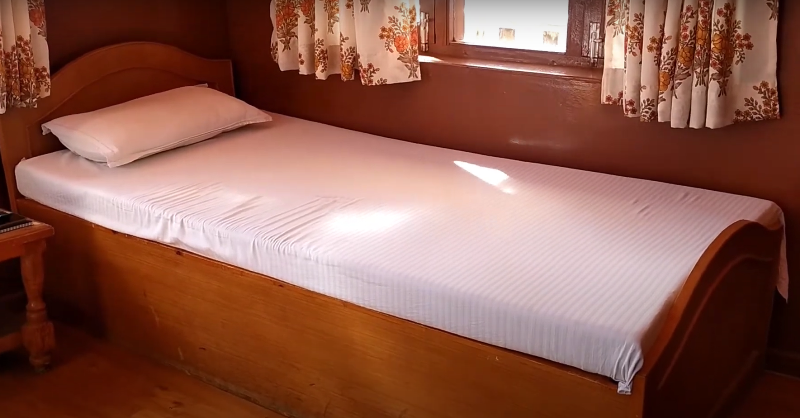
Tea house bed in Annapurna trekking
During the Annapurna Circuit trek, restroom facilities vary, offering both Western toilet pans and more common floor-based pans. While a handful of lodges boast private inside bathrooms, most provide shared facilities that are consistently clean. Emphasizing cleanliness, these lodges maintain hygienic conditions for trekkers. It’s advisable to pack essentials like toilet paper and hand sanitizer. Checking accommodation reviews beforehand can help in choosing places with preferable restroom setups. Despite occasional differences in facilities, the trek’s breathtaking landscapes and cultural experiences overshadow any minor inconveniences, leaving you with enduring memories of this remarkable journey.
While trekking the Annapurna Circuit, staying connected poses a unique challenge. Lodges along the route offer intermittent internet access, and its reliability varies. Wi-Fi is available in some lodges, enabling communication, but the speed may be limited. Charging electronic devices is possible, yet outlets might be scarce. It’s advisable to bring a portable charger and download offline maps or vital information in advance. Embrace the digital detox, savoring the immersive mountain experience. Some remote lodges may have limited or no connectivity, emphasizing the trek’s escape from modern distractions. Be prepared for intermittent connectivity, prioritizing the breathtaking natural surroundings over online presence.
Embarking on the Annapurna Circuit Trail is a breathtaking journey through the Himalayas, and finding the right accommodations is essential for a memorable trek. Teahouses, the traditional lodging option, offer a cozy refuge for weary hikers, serving local cuisine and fostering cultural exchanges. Alternatively, some opt for camping to immerse themselves in nature’s splendor. Popular stops like Manang and Muktinath boast a variety of guesthouses with basic amenities, while the more adventurous may choose rustic lodges in remote areas. Regardless of preference, each accommodation provides a unique perspective of the stunning landscapes that define the Annapurna Circuit Trail experience.
Kathmandu:
In Nepal’s bustling capital, Kathmandu, find a range of accommodations from budget hostels in Thamel to luxury hotels in Durbar Square. Embrace the city’s rich culture and explore historic sites like Swayambhunath Stupa, with lodging options catering to various preferences.
Besisahar:
As the starting point of the Annapurna Circuit, Besisahar offers basic guesthouses catering to trekkers. Accommodations are simple, reflecting the town’s role as a gateway to the stunning Himalayan landscapes ahead.
Bahundanda:
Nestled in the hills, Bahundanda provides modest guesthouses with panoramic mountain views. Embrace the tranquility, enjoy local hospitality, and prepare for the trek ahead in this serene setting.
Chamje:
Chamje, a picturesque village along the Annapurna Circuit, offers small lodges with basic amenities. Enjoy the rustic charm of the surroundings and connect with fellow trekkers in this mountainous haven.
Bagarchap:
With traditional architecture and cozy teahouses, Bagarchap welcomes trekkers with warmth. Accommodations feature local charm, providing a comfortable respite amid the stunning landscapes of the Annapurna region.
Chame:
Chame, the district headquarters of Manang, offers a mix of guesthouses and lodges. Enjoy views of Annapurna II and Lamjung Himal while experiencing the hospitality of this mountain town.
Pisang:
Pisang provides a range of accommodations, from simple teahouses to guesthouses. Enjoy the breathtaking scenery of Pisang Peak and explore the Tibetan-influenced culture while staying in this charming village.
Manang:
As a pivotal point for acclimatization, Manang boasts lodges and guesthouses catering to trekkers’ needs. Enjoy a day of rest, soak in the views of Gangapurna Lake, and prepare for the challenges ahead.
Acclimatization day in Manang:
During the acclimatization day in Manang, trekkers stay in the same accommodations as in Manang. The focus is on rest and adjusting to the altitude, ensuring a smoother ascent in the coming days.
Yak Kharka:
Yak Kharka, a high-altitude grazing area, offers basic teahouses for trekkers. Enjoy the rustic charm and the company of yaks while acclimatizing to the increasing altitude.
Thorong Phedi:
Thorong Phedi serves as the base for crossing Thorong La Pass. Basic lodges provide essential amenities, offering a restful stopover before the challenging ascent to the pass.
Muktinath (via Thorong La Pass):
Muktinath, a sacred pilgrimage site, offers guesthouses with basic facilities. Pilgrims and trekkers find accommodation amidst a unique blend of cultural and natural wonders.
Marpha:
Known for its apple orchards, Marpha offers charming guesthouses. Sample local apple products, experience the town’s rich Tibetan culture, and enjoy comfortable lodging against the backdrop of the Mustang Valley.
Kalopani:
Kalopani, nestled along the Kali Gandaki River, features teahouses with stunning mountain views. Relax by the river, enjoy the rustic charm of the village, and rejuvenate for the remainder of the trek.
Tatopani:
Tatopani, famous for its hot springs, provides guesthouses with a relaxing atmosphere. Unwind in the natural springs, surrounded by lush landscapes, before continuing the trek through the diverse terrain.
Ghorepani:
Ghorepani offers a range of accommodations, including teahouses with beautiful views of the Annapurna and Dhaulagiri ranges. Experience the warmth of the local culture and savor the anticipation of the impending Poon Hill sunrise trek.
Pokhara:
A trek’s endpoint, Pokhara offers diverse accommodations, from lakeside resorts to budget-friendly guesthouses. Relax by Phewa Lake, recount the trekking adventures, and explore the vibrant lakeside atmosphere in this picturesque city.
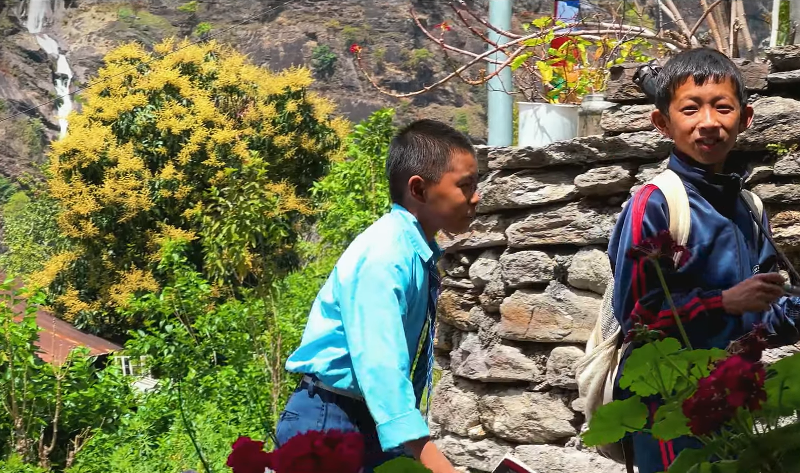
School Kids in Annapurna trekking trail
Certainly! The Annapurna Circuit Trek is a popular trekking route in the Annapurna region of Nepal. Here are some frequently asked questions (FAQs) related to food and accommodation during the Annapurna Circuit Trek:
1. What type of food is available during the trek?
Teahouses along the trail offer a variety of meals, including Nepali, Tibetan, Indian, and international cuisine. Common menu items include dal bhat (lentil soup with rice), momo (dumplings), pasta, noodles, pizza, and more. Breakfast options often include porridge, eggs, toast, and pancakes.
2. Is it safe to drink water along the trek?
It’s recommended to drink purified or boiled water to prevent waterborne diseases. You can bring water purification tablets or use water filters. Bottled water is available at teahouses, but it’s better for the environment to use a refillable water bottle and treat the water.
3. Can I find vegetarian or vegan food options?
Yes, most teahouses offer vegetarian and vegan options. You can find dishes made with vegetables, lentils, and grains. Inform the teahouse staff about your dietary preferences, and they will try to accommodate your needs.
4. How are accommodations arranged along the trail?
The Annapurna Circuit has a network of teahouses providing basic accommodation. Teahouses offer rooms with twin beds, blankets, and shared bathrooms. It’s advisable to carry a sleeping bag for added warmth, especially during the colder months.
5. Do I need to book accommodation in advance?
In most cases, you don’t need to book accommodation in advance during the trek. There are plenty of teahouses along the route, and you can find a place to stay upon arrival. However, during peak trekking seasons, it’s a good idea to start early and secure a room, especially in popular villages.
6. Are there hot showers available during the trek?
Yes, many teahouses have hot shower facilities, but they often come with an additional cost. In some higher-altitude places, hot water may be scarce, and teahouses may use solar or alternative heating methods.
7. What is the cost of meals and accommodation on the Annapurna Circuit?
Costs can vary, but in general, meals are reasonably priced, and accommodation costs are relatively low. Prices may increase at higher altitudes. It’s advisable to carry some cash, as credit card facilities may not be available in remote areas.
8. Can I charge my electronic devices along the trek?
Most teahouses have charging facilities, but there might be a fee for using power outlets. Bring a portable power bank to ensure you can charge your devices when electricity is not available.
To sum it up, when trekking the Annapurna Circuit, remember that good food and accommodation are key for a memorable journey. Enjoy local dishes and choose cozy tea houses wisely. These simple tips can make your trek more enjoyable. The unique flavors and nights under the Himalayan sky are part of the adventure. So, keep these in mind for an unforgettable experience on the Annapurna Circuit—an incredible trek filled with great food, cozy stays, and cultural discoveries.